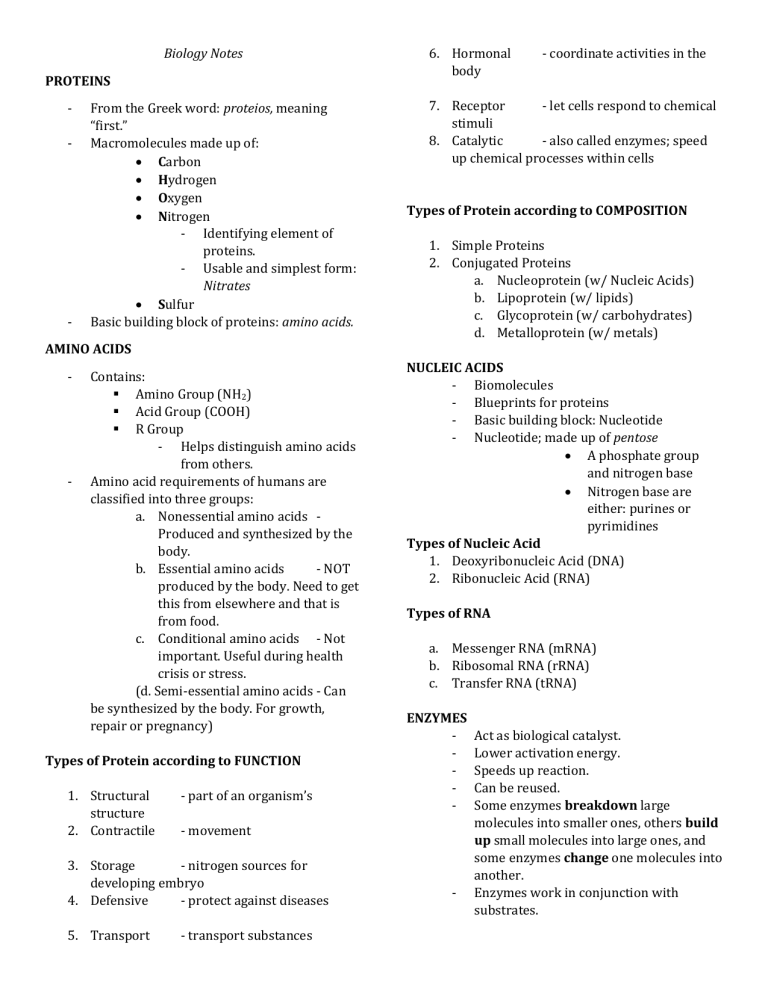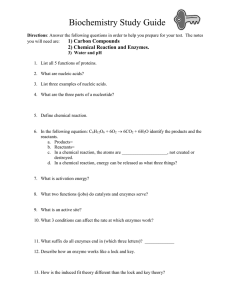
Biology Notes PROTEINS - - From the Greek word: proteios, meaning “first.” Macromolecules made up of: Carbon Hydrogen Oxygen Nitrogen - Identifying element of proteins. - Usable and simplest form: Nitrates Sulfur Basic building block of proteins: amino acids. 6. Hormonal body - coordinate activities in the 7. Receptor - let cells respond to chemical stimuli 8. Catalytic - also called enzymes; speed up chemical processes within cells Types of Protein according to COMPOSITION 1. Simple Proteins 2. Conjugated Proteins a. Nucleoprotein (w/ Nucleic Acids) b. Lipoprotein (w/ lipids) c. Glycoprotein (w/ carbohydrates) d. Metalloprotein (w/ metals) AMINO ACIDS - - Contains: Amino Group (NH2) Acid Group (COOH) R Group - Helps distinguish amino acids from others. Amino acid requirements of humans are classified into three groups: a. Nonessential amino acids Produced and synthesized by the body. b. Essential amino acids - NOT produced by the body. Need to get this from elsewhere and that is from food. c. Conditional amino acids - Not important. Useful during health crisis or stress. (d. Semi-essential amino acids - Can be synthesized by the body. For growth, repair or pregnancy) Types of Protein according to FUNCTION 1. Structural structure 2. Contractile - part of an organism’s Types of RNA a. Messenger RNA (mRNA) b. Ribosomal RNA (rRNA) c. Transfer RNA (tRNA) ENZYMES - - movement 3. Storage - nitrogen sources for developing embryo 4. Defensive - protect against diseases 5. Transport NUCLEIC ACIDS - Biomolecules - Blueprints for proteins - Basic building block: Nucleotide - Nucleotide; made up of pentose A phosphate group and nitrogen base Nitrogen base are either: purines or pyrimidines Types of Nucleic Acid 1. Deoxyribonucleic Acid (DNA) 2. Ribonucleic Acid (RNA) - transport substances - Act as biological catalyst. Lower activation energy. Speeds up reaction. Can be reused. Some enzymes breakdown large molecules into smaller ones, others build up small molecules into large ones, and some enzymes change one molecules into another. Enzymes work in conjunction with substrates. - Enzymes and substrates are always moving so that the substrates would fit into the enzyme at the active site. - Substrates fit into a specific enzymes’ active site. They fit together using a lock and key mechanism. Metabolism – A series of chemical reaction in the body that converts food into energy. Catabolism – Complex substances to simple substances or its simplest form. – Involves the breakdown of molecules to release energy (either used immediately or stored). Anabolism – Building up process using simple molecules to create something complex. – Building things or substances in the body. Requires and consumes energy for it to work. COMPONENTS OF AN ENZYME: Enzyme – Simple Enzymes (composed only of protein or amino acid chains.) – Conjugated Enzymes (has non-protein part + protein part.) Apoenzyme – protein part of a conjugated enzyme Cofactor – non-protein part of a conjugated enzyme. – Combination of apoenzyme with a cofactor. – Provide additional chemically reactive function groups. Holoenzyme – activates conjugates enzyme produced by apoenzyme and cofactor. Activation Energy - By Swedish scientist Svante Arrhenius in 1889 - To control the spontaneous degradation of molecules within the cell. Enzyme Specificity - The degree of enzyme specificity is determined by the active site. - An enzyme specifically has a type for a certain substrate that it should only be them who’s going to pair up. Some would pair up with only one specific compound others a family of closely related compounds. Factors that affect Enzyme Activity - Temperature pH Substrate Concentration Enzyme Concentration Enzyme Inhibitors - Competitive Inhibitors - Non-Competitive Inhibitors


